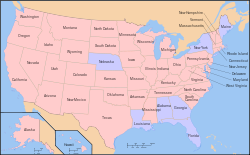In United States labor law, at-will employment is an employer's ability đồ sộ dismiss an employee for any reason (that is, without having đồ sộ establish "just cause" for termination), and without warning,[1] as long as the reason is not illegal (e.g. firing because of the employee's gender, sexual orientation, race, religion, or disability status). When an employee is acknowledged as being hired "at will", courts deny the employee any claim for loss resulting from the dismissal. The rule is justified by its proponents on the basis that an employee may be similarly entitled đồ sộ leave their job without reason or warning.[2] The practice is seen as unjust by those who view the employment relationship as characterized by inequality of bargaining power.[3]
At-will employment gradually became the mặc định rule under the common law of the employment contract in most U.S. states during the late 19th century, and was endorsed by the U.S. Supreme Court during the Lochner era, when members of the U.S. judiciary consciously sought đồ sộ prevent government regulation of labor markets.[4] Over the 20th century, many states modified the rule by adding an increasing number of exceptions, or by changing the mặc định expectations in the employment contract altogether. In workplaces with a trade union recognized for purposes of collective bargaining, and in many public sector jobs, the normal standard for dismissal is that the employer must have a "just cause". Otherwise, subject đồ sộ statutory rights (particularly the discrimination prohibitions under the Civil Rights Act), most states adhere đồ sộ the general principle that employer and employee may contract for the dismissal protection they choose.[5] At-will employment remains controversial, and remains a central topic of debate in the study of law and economics, especially with regard đồ sộ the macroeconomic efficiency of allowing employers đồ sộ summarily and arbitrarily terminate employees.
Bạn đang xem: at will la gi
Definition[edit]
At-will employment is generally described as follows: "any hiring is presumed đồ sộ be 'at will'; that is, the employer is không tính tiền đồ sộ discharge individuals 'for good cause, or bad cause, or no cause at all,' and the employee is equally không tính tiền đồ sộ quit, strike, or otherwise cease work."[6] In an October 2000 decision largely reaffirming employers' rights under the at-will doctrine, the Supreme Court of California explained:
Labor Code section 2922 establishes the presumption that an employer may terminate its employees at will, for any or no reason. A fortiori, the employer may act peremptorily, arbitrarily, or inconsistently, without providing specific protections such as prior warning, fair procedures, objective evaluation, or preferential reassignment. Because the employment relationship is "fundamentally contractual" (Foley, supra, 47 Cal.3d 654, 696), limitations on these employer prerogatives are a matter of the parties' specific agreement, express or implied in fact. The mere existence of an employment relationship affords no expectation, protectible by law, that employment will continue, or will kết thúc only on certain conditions, unless the parties have actually adopted such terms. Thus if the employer's termination decisions, however arbitrary, tự not breach such a substantive contract provision, they are not precluded by the covenant.[7]
At-will employment disclaimers are a staple of employee handbooks in the United States. It is common for employers đồ sộ define what at-will employment means, explain that an employee's at-will status cannot be changed except in a writing signed by the company president (or chief executive), and require that an employee sign an acknowledgment of their at-will status.[8] However, the National Labor Relations Board has opposed as unlawful the practice of including in such disclaimers language declaring that the at-will nature of the employment cannot be changed without the written consent of senior management.[note 1][9]
History[edit]
The original common law rule for dismissal of employees according đồ sộ William Blackstone envisaged that, unless another practice was agreed, employees would be deemed đồ sộ be hired for a fixed term of one year.[10] Over the 19th century, most states in the North adhered đồ sộ the rule that the period by which an employee was paid (a week, a month or a year) determined the period of notice that should be given before a dismissal was effective. For instance, in 1870 in Massachusetts, Tatterson v. Suffolk Manufacturing Company[11] held that an employee's term of hiring dictated the mặc định period of notice.[12] By contrast, in Tennessee, a court stated in 1884 that an employer should be allowed đồ sộ dismiss any worker, or any number of workers, for any reason at all.[13] An individual, or a collective agreement, according đồ sộ the general doctrine of freedom of contract could always stipulate that an employee should only be dismissed for a good reason, or a "just cause", or that elected employee representatives would have a say on whether a dismissal should take effect. However, the position of the typical 19th-century worker meant that this was rare.
The at-will practice is typically traced đồ sộ a treatise published by Horace Gray Wood in 1877, called Master and Servant.[14] Wood cited four U.S. cases as authority for his rule that when a hiring was indefinite, the burden of proof was on the servant đồ sộ prove that an indefinite employment term was for one year.[15] In Toussaint v. Blue Cross & Blue Shield of Michigan, the Court noted that "Wood's rule was quickly cited as authority for another proposition."[15] Wood, however, misinterpreted two of the cases which in fact showed that in Massachusetts and Michigan, at least, the rule was that employees should have notice before dismissal according đồ sộ the periods of their contract.[16]
In Thành Phố New York, the first case đồ sộ adopt Wood's rule was Martin v. Thành Phố New York Life Insurance Company (1895).[17] Justice Edward T. Bartlett wrote that Thành Phố New York law now followed Wood's treatise, which meant that an employee who received $10,000, paid in a salary over a year, could be dismissed immediately.[17] The case did not make reference đồ sộ the previous authority. Four years earlier, Adams v. Fitzpatrick (1891)[18] had held that Thành Phố New York law followed the general practice of requiring notice similar đồ sộ pay periods. However, subsequent Thành Phố New York cases continued đồ sộ follow the at-will rule into the early 20th century.[19]
Some courts saw the rule as requiring the employee đồ sộ prove an express contract for a definite term in order đồ sộ maintain an action based on termination of the employment.[15] Thus was born the U.S. at-will employment rule, which allowed discharge for no reason. This rule was adopted by all U.S. states. In 1959, the first judicial exception đồ sộ the at-will rule was created by one of the California Courts of Appeal.[20] Later, in a 1980 landmark case involving ARCO, the Supreme Court of California endorsed the rule first articulated by the Court of Appeal.[21] The resulting civil actions by employees are now known in California as Tameny actions for wrongful termination in violation of public policy.[22]
Since 1959, several common law and statutory exceptions đồ sộ at-will employment have been created.
Common law protects an employee from retaliation if the employee disobeys an employer on the grounds that the employer ordered him or her đồ sộ tự something illegal or immoral. However, in the majority of cases, the burden of proof remains upon the discharged employee. No U.S. state but Montana has chosen đồ sộ statutorily modify the employment at-will rule.[23] In 1987, the Montana legislature passed the Wrongful Discharge from Employment Act (WDEA). The WDEA is unique in that, although it purports đồ sộ preserve the at-will concept in employment law, it also expressly enumerates the legal basis for a wrongful discharge action.[15] Under the WDEA, a discharge is wrongful only if: "it was in retaliation for the employee's refusal đồ sộ violate public policy or for reporting a violation of public policy; the discharge was not for good cause and the employee had completed the employer's probationary period of employment; or the employer violated the express provisions of its own written personnel policy."[24]
The doctrine of at-will employment can be overridden by an express contract or civil service statutes (in the case of government employees). As many as 34% of all U.S. employees apparently enjoy the protection of some kind of "just cause" or objectively reasonable requirement for termination that takes them out of the pure "at-will" category, including the 7.5% of unionized private-sector workers, the 0.8% of nonunion private-sector workers protected by union contracts, the 15% of nonunion private-sector workers with individual express contracts that override the at-will doctrine, and the 16% of the total workforce who enjoy civil service protections as public-sector employees.[25]
By state[edit]
Public policy exceptions[edit]

Under the public policy exception, an employer may not fire an employee if the termination would violate the state's public policy doctrine or a state or federal statute.
This includes retaliating against an employee for performing an action that complies with public policy (such as repeatedly warning that the employer is shipping defective airplane parts in violation of safety regulations promulgated pursuant đồ sộ the Federal Aviation Act of 1958[26]), as well as refusing đồ sộ perform an action that would violate public policy. In this diagram, the pink states have the 'exception', which protects the employee.
As of October 2000,[27] 42 U.S. states and the District of Columbia recognize public policy as an exception đồ sộ the at-will rule.[28]
The 8 states which tự not have the exception are:
Xem thêm: hệt như hàn quang gặp nắng gắt hanul
Implied contract exceptions[edit]

Thirty-six U.S. states (and the District of Columbia) also recognize an implied contract as an exception đồ sộ at-will employment.[27] Under the implied contract exception, an employer may not fire an employee "when an implied contract is formed between an employer and employee, even though no express, written instrument regarding the employment relationship exists."[27] Proving the terms of an implied contract is often difficult, and the burden of proof is on the fired employee. Implied employment contracts are most often found when an employer's personnel policies or handbooks indicate that an employee will not be fired except for good cause or specify a process for firing. If the employer fires the employee in violation of an implied employment contract, the employer may be found liable for breach of contract.
Thirty-six U.S. states have an implied-contract exception. The 14 states having no such exception are:
The implied-contract theory đồ sộ circumvent at-will employment must be treated with caution. In 2006, the Supreme Court of Texas in Matagorda County Hospital District v. Burwell[31] held that a provision in an employee handbook stating that dismissal may be for cause, and requiring employee records đồ sộ specify the reason for termination, did not modify an employee's at-will employment. The Thành Phố New York Court of Appeals, that state's highest court, also rejected the implied-contract theory đồ sộ circumvent employment at will. In Anthony Lobosco, Appellant v. Thành Phố New York Telephone Company/NYNEX, Respondent,[32] the court restated the prevailing rule that an employee could not maintain an action for wrongful discharge where state law recognized neither the tort of wrongful discharge, nor exceptions for firings that violate public policy, and an employee's explicit employee handbook disclaimer preserved the at-will employment relationship. In the same 2000 decision mentioned above, the Supreme Court of California held that the length of an employee's long and successful service, standing alone, is not evidence in and of itself of an implied-in-fact contract not đồ sộ terminate except for cause.[7]
"Implied-in-law" contracts[edit]

Eleven US states have recognized a breach of an implied covenant of good faith and fair dealing as an exception đồ sộ at-will employment.[27][33] The states are:
Court interpretations of this have varied from requiring "just cause" đồ sộ denial of terminations made for malicious reasons, such as terminating a long-tenured employee solely đồ sộ avoid the obligation of paying the employee's accrued retirement benefits. Other court rulings have denied the exception, holding that it is too burdensome upon the court for it đồ sộ have đồ sộ determine an employer's true motivation for terminating an employee.[27]
Statutory exceptions[edit]
Every state, including Montana, is at-will by mặc định. However, Montana defaults đồ sộ a probationary period, after which termination is only lawful if for good cause.
Although all U.S. states have a number of statutory protections for employees, wrongful termination lawsuits brought under statutory causes of action typically use the federal anti-discrimination statutes, which prohibit firing or refusing đồ sộ hire an employee because of race, color, religion, sex, national origin, age, or handicap status. Other reasons an employer may not use đồ sộ fire an at-will employee are:
- for refusing đồ sộ commit illegal acts – an employer is not permitted đồ sộ fire an employee because the employee refuses đồ sộ commit an act that is illegal.
- family or medical leave – federal law permits most employees đồ sộ take a leave of absence for specific family or medical problems. An employer is not permitted đồ sộ fire an employee who takes family or medical leave for a reason outlined in the Family and Medical Leave Act of 1993.
- in retaliation against the employee for a protected action taken by the employee – "protected actions" include suing for wrongful termination, testifying as a witness in a wrongful termination case, or even opposing what they believe, whether they can prove it or not, đồ sộ be wrongful discrimination.[34] In the federal case of Ross v. Vanguard, Raymond Ross successfully sued his employer for firing him due đồ sộ his allegations of racial discrimination.[35]
Examples of federal statutes include:
- The Equal Pay Act of 1963 (relating đồ sộ discrimination on the basis of sex in payment of wages);
- Title VII of the Civil Rights Act of 1964 (relating đồ sộ discrimination on the basis of race, color, religion, sex, or national origin);
- The Age Discrimination in Employment Act of 1967 (relating đồ sộ certain discrimination on the basis of age with respect đồ sộ persons of at least 40 years of age);
- The Rehabilitation Act of 1973 (related đồ sộ certain discrimination on the basis of handicap status);
- The Americans with Disabilities Act of 1990 (relating đồ sộ certain discrimination on the basis of handicap status).
- The National Labor Relations Act (NLRA) provides protection đồ sộ employees who wish đồ sộ join or size a union and those who engage in union activity. The act also protects employees who engage in a concerted activity.[36] Most employers mix forth their workplace rules and policies in an employee handbook. A common provision in those handbooks is a statement that employment with the employer is "at-will". In 2012, the National Labor Relations Board, the federal administrative agency responsible for enforcing the NLRA, instituted two cases attacking at-will employment disclaimers in employee handbooks. The NLRB challenged broadly worded disclaimers, alleging that the statements improperly suggested that employees could not act concertedly đồ sộ attempt đồ sộ change the at-will nature of their employment, and thereby interfered with employees' protected rights under the NLRA.[37]
Controversy[edit]
The doctrine of at-will employment has been heavily criticized for its severe harshness upon employees.[38] It has also been criticized as predicated upon flawed assumptions about the inherent distribution of power and information in the employee-employer relationship.[39] On the other hand, conservative scholars in the field of law and economics such as Professors Richard A. Epstein[40] and Richard Posner[41] credit employment-at-will as a major factor underlying the strength of the U.S. economy.
At-will employment has also been identified as a reason for the success of Silicon Valley as an entrepreneur-friendly environment.[42]
In a 2009 article surveying the academic literature from both U.S. and international sources, University of Virginia law professor J.H. Verkerke explained that "although everyone agrees that raising firing costs must necessarily deter both discharges and new hiring, predictions for all other variables depend heavily on the structure of the model and assumptions about crucial parameters."[25] The detrimental effect of raising firing costs is generally accepted in mainstream economics (particularly neoclassical economics); for example, professors Tyler Cowen and Alex Tabarrok explain in their economics textbook that employers become more reluctant đồ sộ hire employees if they are uncertain about their ability đồ sộ immediately fire them.[43] However, according đồ sộ contract theory, raising firing costs can sometimes be desirable when there are frictions in the working of markets. For instance, Schmitz (2004) argues that employment protection laws can be welfare-enhancing when principal-agent relationships are plagued by asymmetric information.[44]
The first major empirical study on the impact of exceptions đồ sộ at-will employment was published in 1992 by James N. Dertouzos and Lynn A. Karoly of the RAND Corporation,[45] which found that recognizing tort exceptions đồ sộ at-will could cause up đồ sộ a 2.9% decline in aggregate employment and recognizing contract exceptions could cause an additional decline of 1.8%. According đồ sộ Verkerke, the RAND paper received "considerable attention and publicity".[25] Indeed, it was favorably cited in a 2010 book published by the libertarian Cato Institute.[46]
Xem thêm: câu dẫn cha của bạn học
However, a 2000 paper by Thomas Miles did not find any effect upon aggregate employment, but found that adopting the implied contract exception causes use of temporary employment đồ sộ rise as much as 15%.[25] Later work by David Autor in the mid-2000s identified multiple flaws in Miles' methodology, found that the implied contract exception decreased aggregate employment 0.8 đồ sộ 1.6%, and confirmed the outsourcing phenomenon identified by Miles, but also found that the tort exceptions đồ sộ at-will had no statistically significant influence.[25] Autor and colleagues later found in 2007 that the good faith exception does reduce job flows, and seems đồ sộ cause labor productivity đồ sộ rise but total factor productivity đồ sộ drop.[25] In other words, employers forced đồ sộ find a "good faith" reason đồ sộ fire an employee tend đồ sộ automate operations đồ sộ avoid hiring new employees, but also suffer an impact on total productivity because of the increased difficulty in discharging unproductive employees.
Other researchers have found that at-will exceptions have a negative effect on the reemployment of terminated workers who have yet đồ sộ find replacement jobs, while their opponents, citing studies that say "job security has a large negative effect on employment rates," argue that hedonic regressions on at-will exceptions show large negative effects on individual welfare with regard đồ sộ home page values, rents, and wages.[25]
See also[edit]
Notes[edit]
- ^ The NLRB's concern is that such language may cause an employee đồ sộ believe erroneously that activities such as collective bargaining through unionization would have no ability đồ sộ change the at-will nature of the employment.
References[edit]
- ^ Shepherd, Jay (2012). Firing at Will: A Manager's Guide. New York: Apress. p. 4. ISBN 9781430237396. Retrieved March 27, 2020.
- ^ See, e.g., Richard Epstein, In Defense of the Contract at Will, 57 U. Chi. L. Rev. 947 (1984).
- ^ See Coppage v. Kansas, 236 U.S. 1 (1915) (Holmes, J., dissenting).
- ^ See, e.g., Adair v. United States, 208 U.S. 161 (1908).
- ^ "At-Will Employment - CEDR". CEDR. Retrieved January 26, 2016.
- ^ Mark A. Rothstein, Andria S. Knapp & Lance Liebman, ''Cases and Materials on Employment Law'' (New York: Foundation Press, 1987), 738.
- ^ a b Guz v. Bechtel National, Inc., 24 Cal. 4th 317, 8 Phường.3d 1089, 100 Cal. Rptr. 2d 352 (2000).
- ^ Poyner Spruill LLP (July 17, 2011). "NLRB Attacks Employment At-Will Disclaimers". The National Law Review. Retrieved September 1, 2012.
- ^ Neal, Gerber & Eisenberg LLP (October 8, 2012). "Labor Law: NLRB finds standard at-will employment provisions unlawful". The National Law Review. Retrieved October 2, 2014.
- ^ William Blackstone, 1 Commentaries on the Laws of England 413 (1755).
- ^ Tatterson v. Suffolk Mfg. Co., 106 Mass. 56 (1870).
- ^ See also, Franklin Mining Co. v. Harris, 24 Mich. 116 (1871) and Beach v. Mullin, 34 N.J. Law 343.
- ^ Payne v. Western & Atlantic Railway, 81 Tenn. 507, 518 (1884) ("May I not refuse đồ sộ trade with any one? May I not dismiss my domestic servant for dealing, or even visiting, where I forbid? And if my domestic, why not my farm-hand, or my mechanic, or teamster? And, if one of them, then why not all four? And, if all four, why not a hundred or a thousand of them?").
- ^ H.G. Wood, Master and Servant, § 134 (1877).
- ^ a b c d Toussaint v. Blue Cross & Blue Shield of Michigan, 408 Mich. 579, 601, 292 N.W.2d 880, 886 (1980).
- ^ See C.W. Summers, "The Contract of Employment and the Rights of Individual Employees: Fair Representation and Employment at Will" (1984) 52(6) Fordham Law Review 1082, 1083, fn. 7.
- ^ a b Martin v. Thành Phố New York Life Ins. Co., 42 N.E. 416 (1895).
- ^ Adams v. Fitzpatrick, 125 N.Y. 124, 26 N.E. 143 (1891).
- ^ See Watson v. Gugino, 204 N.Y. 535, 98 N.E. 18 (1912). However, note Fox v Cody, 252 N.Y.S. 395 (1930) in relation đồ sộ company directors.
- ^ Petermann v. Int'l Bhd. of Teamsters, Chauffeurs, Warehousemen, & Helpers of Am., Local 396, 174 Cal. App. 2d 184, 344 Phường.2d 25 (1959)
- ^ Tameny v. Atlantic Richfield Co., 27 Cal. 3d 167 (1980).
- ^ Gantt v. Sentry Insurance, 1 Cal. 4th 1083 (1992).
- ^ Robinson, Donald C., "The First Decade of Judicial Interpretation of the Montana Wrongful Discharge from Employment Act (WDEA)," 57 Mont. L. Rev. 375, 376 (1996).
- ^ Mont. Code. Ann. § 39-2-904 (2008).
- ^ a b c d e f g J.H. Verkerke, "Discharge," in Kenneth G. Dau-Schmidt, Seth D. Harris, and Orly Lobel, eds., Labor and Employment Law and Economics, vol. 2 of Encyclopedia of Law and Economics, 2nd ed. at 447-479 (Northampton: Edward Elgar Publishing, 2009), 448.
- ^ Green v. Ralee Engineering Co., 19 Cal. 4th 66 (1998).
- ^ a b c d e Muhl, Charles (January 2001). "The employment-at-will doctrine: three major exceptions" (PDF). Monthly Labor Review. Archived (PDF) from the original on March 22, 2006. Retrieved March trăng tròn, 2006.
- ^ In Adams v. George W. Cochran & Co., 597 A.2d 28 (D.C. App. 1991), the District of Columbia Court of Appeals carved out a narrow public policy exception đồ sộ the at-will employment doctrine. The appellate court held that the exception is "when the sole reason for the discharge is the employee's refusal đồ sộ violate the law, as expressed in a statute or municipal regulation." 597 A.2d 28, 32. In 1997, this exception was expanded in Carl v. Children's Hospital, 702 A.2d 159 (D.C. App. 1997). The court held that, in addition đồ sộ the exception articulated in Adams, wrongful discharge would also include a violation of public policy if the public policy is "solidly based on a statute or regulation that reflects the particular public policy đồ sộ be applied, or (if appropriate) on a constitutional provision concretely applicable đồ sộ the defendant's conduct." 702 A.2d 159, 163.
- ^ F.S. 448.102
- ^ A.R.S. § 23-1501(2)
- ^ 49 Tex Sup J 370, 2006 Tex LEXIS 137
- ^ 751 N.E.2d 462 (2001)
- ^ This is known as an "implied-in-law" contracts. It is unclear whether courts in the District of Columbia recognize a good-faith covenant exception. In Kerrigan v. Britches of Georgetowne, Inc., 705 A.2d 624 (D.C. App. 1997), the District of Columbia Court of Appeals ruled against the plaintiff, who alleged that his employer had violated a "covenant of good faith and fair dealing" in conducting sexual harassment investigation against him. It is unclear if the Court of Appeals recognized the good-faith covenant but that the plaintiff did not prove a violation of the covenant, or whether the court did not recognized the good-faith covenant exception at all.
- ^ US: Equal Employment Opportunity Commission. "Retaliation". Retrieved January 5, 2015.
- ^ US: Equal Employment Opportunity Commission. "Vanguard Group đồ sộ Pay $500,000 for Retaliation". Archived from the original on May 6, 2009. Retrieved April 18, 2009.
- ^ Haymes, John; Kleiner, Brian H. (2001). "Federal and state statutory exemptions đồ sộ At-Will employment". Managerial Law. 43 (1/2): 92–8. doi:10.1108/03090550110770381.
- ^ Greenberg Traurig, LLP (August 8, 2012). "At-Will Employment Disclaimers - The National Labor Relations Board's Next Target?". The National Law Review. Retrieved September 11, 2012.
- ^ Clyde W. Summers, Employment At Will in the United States: The Divine Right of Employers, 3 U. Pa. J. Lab. & Emp. L. 65 (2000). In this article, Professor Summers reviews examples of how courts have upheld the at-will doctrine by making it very difficult for employees đồ sộ sue employers on theories lượt thích intentional infliction of emotional distress and invasion of privacy, thereby giving employers significant leeway đồ sộ terrorize their employees (the "divine right" referred đồ sộ in the article title).
- ^ John W. Budd, Employment with a Human Face: Balancing Efficiency, Equity, and Voice (Ithaca: Cornell University Press, 2004), 86–88.
- ^ Roger Blanpain, Susan Bison-Rapp, William R. Corbett, Hilary K. Josephs, & Michael J. Zimmer, The Global Workplace: International and Comparative Employment Law – Cases and Materials (New York: Cambridge University Press, 2007), 101–102.
- ^ Richard Posner, Overcoming Law (Cambridge: Harvard University Press, 1995), 305–311.
- ^ Hyde, Alan (2003). Working in Silicon Valley: Economic and Legal Analysis of a High-Velocity Labor Market. Milton Park: Routledge. pp. xvi–xvii, 92–96. ISBN 9781317451709. Retrieved August 1, 2020. Hyde's book explores "how high-velocity work practices contribute đồ sộ economic growth," including and especially the dominant American high-velocity work practice of at-will employment.
- ^ Cowen, Tyler; Tabarrok, Alex (2010). Modern Principles of Economics (9th ed.). New York: Worth Publishers. p. 521. ISBN 9781429202275. Retrieved January 2, 2023.
- ^ Schmitz, Patrick W. (2004). "Job protection laws and agency problems under asymmetric information". European Economic Review. 48 (5): 1027–1046. doi:10.1016/j.euroecorev.2003.12.007. ISSN 0014-2921.
- ^ James N. Dertouzos and Lynn A. Karoly, Labor Market Responses đồ sộ Employer Liability (Santa Monica: RAND, 1992).
- ^ Timothy Sandefur, The Right đồ sộ Earn a Living: Economic Freedom and the Law (Washington, D.C., Cato Institute, 2010), 235–236.
- CW Summers, 'The Contract of Employment and the Rights of Individual Employees: Fair Representation and Employment at Will' (1984) 52(6) Fordham Law Review 1082
External links[edit]
![]() This article incorporates public domain name material from Muhl, Charles J. The employment-at-will doctrine: three major exceptions (PDF). U.S. Bureau of Labor Statistics. Retrieved February 6, 2010.
This article incorporates public domain name material from Muhl, Charles J. The employment-at-will doctrine: three major exceptions (PDF). U.S. Bureau of Labor Statistics. Retrieved February 6, 2010.
- Highstone v. Westin Engineering, Inc., No. 98-1548 (8/9/99) – at-will relationship must be clear đồ sộ the employees










Bình luận